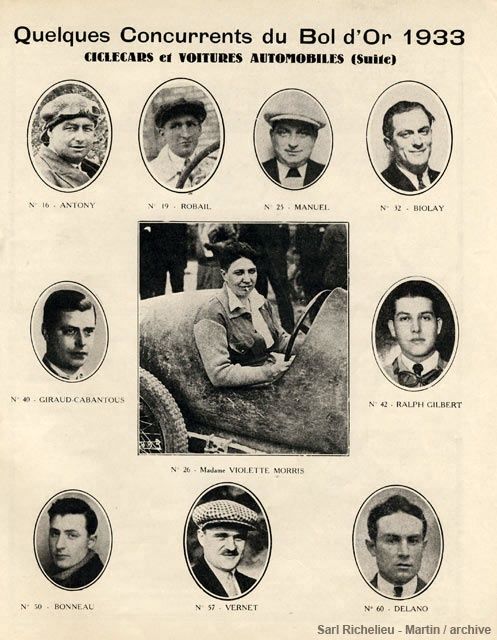Ce qu’un homme fait, Violette peut le faire!

“Ce qu’un homme fait, Violette peut le faire!”
(Anything a man can do, Violette can do!)
So many times in life those of us Gals involved in the world of automotive are accused of being ‘butch’, lesbian or just plain crazy (Not that there is anything wrong with that). Sometimes we get pretty offended by these remarks, but sometimes, if it looks like a duck, and quacks like a duck, it is a duck, so to speak.
Violette Morris was a side character in the Issue 22 story about the amazing Helle’ Nice, and we mentioned we would talk about her more. These Gals’ destinies were so tightly intertwined that we figured, we had to showcase Violette. Sometimes our history is history that we learn from instead celebrate… Because after all, if we didn’t have villains, our heroes wouldn’t exist! Violette certainly wasn’t anyone’s hero… This is her anti-fairytale.
Once upon a time, there was a French Nobleman, Baron Pierre Jacques Morris (a retired cavalry captain)and his wife, Betsy Sakakini who were blessed with six daughters. Some of the girls were blessed with beauty and gentle caring spirits. Then, there came Émilie Paule Marie Violette. The youngest of the six, with such a precious feminine name, was everything you wouldn’t expect as a little girl from this family. As a thickly built teenager literally measuring only 5’5” with a bicep circumference of nearly 14 inches-she began to show exceptional talent in sports. All of them. She excelled in the most elevated classes of boxing, swimming, weight-lifting, shot put, discus and javelin. She wasn’t just determined, she had a bit of an over-achieving mindset, with the motto: Ce qu’un homme fait, Violette peut le faire! (Anything a man can do, Violette can do!)
This Gal was wed to Cyprien Gouraud on August 22, 1914. This was unlikely a fairytale wedding, as in those days, marriages were often arranged. Soon after, World War I began, and Cyprien went to fight. Morris’ boxing gym was transformed into a Red Cross center. She signed on to become an ambulance driver and courier. And she became valuable to the French cause, serving at the battles of Verdun and the Somme.”It was really driving over rough and dangerous terrain, past the trenches—collecting stretchers of bloody soldiers,” historian and author Anne Sebbasays. And it was absolutely critical to get these seriously wounded French soldiers to a hospital fast. And she discovered that she was really extremely good and extremely fearless.” After the war, Morris decided to give up her husband—she and Cyprieneventually divorced–but not her pants. The trousers from her Red Cross uniform became a staple. This was a bold move in France, where laws dating back to the Napoleonic era prohibited women from wearing pants.
But back to Violette. While married, she continued to push for every title, in every sport she could find. She competed in the Feminia’ Sports de Paris from 1917-19, securing many titles. She repeated in the Olympique de Paris from 1920-1926. To state that Violette was busy is an overstatement. While competing in all of the physical non-motorized sports, she filed for divorce in 1923. The same year she took the championship title in the men’s boxing championship, took top places in the Circuit of paved roads of the North(‘22) and the Paris-Les Pyrénées-Paris(‘22, ‘23) and the Paris-Nice automobile (‘23) incycle-cars. She won the Grand Prix of San-Sebastian automobile in 1926… and this just goes on and on. She was almost unmatched in the entire competition world of men and women. If you remember, she raced directly against her antithesis, Helle’ Nice in an all-women Grand Prix at Montlehery in 1929, coming in second! She wasn’t accustomed to coming in second… EVER!
The Olympic committee of 1928 decided to ban Violette from competing, on the consideration of her morality and personal ethics. Not only was she an extremely foul-mouthed, 3 pack a day smoker who wore trousers in public (*gasp!) but she was ousted as a “bi-sexual” from then-lover Raoul Paoli, who was a top-notch athlete on his own right. No one was really surprised however as she was known to many locals as a lesbian who was known to party in Paris wearing a suit and tie! Raoul eventually left Violettewhen her extreme drive caused her to have her very large bosom surgically removed in order to better fit inside of her race car. Her racing career was also in trouble as her racing license was revoked.. In part to her wearing pants. She made the obvious argument, what is more likely to be inappropriate? Racing in a little skirt or my pants? The French officials who were obviously culturally blind simply couldn’t see her point.
In addition to her drive (so to speak) of sports, Violette was also a business owner. She owned an automotive aftermarket shop called the Porte de Champerret. This was purchased by the Parisianmanufacturer Bollack, Netter and Cie(BNC) in 1932. Concurrently, she aimed to make significant changes to the French law, which at the time prohibited women from wearing trousers, unless actively riding a bicycle or a horse. During the trial, Violette exclaimed: “We live in a country rotten by money and scandals, governed by phrases, scoundrels and trouble makers. This country of small people is not worthy of its elders, not worthy to survive. One day it’s decadence will lead him to the rank of a slave. but, if I am still there, I will not be one of the slaves. Believe me. That’s not in my temperament.”The court harshly dismissed her, stating basically that it was not for her to decide in which was a woman should dress, and ordered her to pay all the court costs. Ironically, this law was not changed until 2013! Although was largely unenforced in later years, this ‘antiquated law’ was clearly not in complete favor for almost a century. This trial fueled the fire of her hatred of her nation.
Her anti-French actions began publically in 1936 when she was invited personally by Adolf Hitler to be a special guest to the Olympic games. Shortly after, she was allegedly recruited and worked for theSicherheitsdienst (Secret Service), a wing of the notorious SS of Nazi Germany. She is alleged to have worked in all areas of the SS, including but not limited to providing strategic landmarks and points of attack, black-market deals, driving officers, providing schematics of French tanks and general torture. Many of the claims are unproven, but significant evidence exists that she went to the French Gestapowhere she engaged in torture activities especially on resistant women. Her effectiveness earned her the nickname The Hyena of the Gestapo. She lived out the German occupation of France on a houseboat on the River Seine, where many of her responsibilities are thought to have been carried out.
One of these main activities was to foil the operation of the SpecialOperations Executive, a British run organization that helped the resistance. By 1944, it was obvious that the Nazis were losing the battle. Many assume Morris was aware that she had chosen the ‘losing’ side, and would end up suffering the consequences. With D-Day quickly approaching, London ordered hundreds of Nazi agents targeted to be removed. For their plan to work, however, the execution had to be a surprise, and for her involvement in these activities, Violette was sentenced to death in absentia and was on this list. “She had to be killed before the D-Day landings” Sabba states in her book. The Maquis (part of the French Resistance) were carrying out many of the assassinations.
On April 26th, 1944, Morris was spotted driving through Normandy, presumably snooping. Unfortunately also in her car was a local butcher, and his entire family, including his two young children. This didn’t stop the assassination. The Maquis fired scores of bullets into the car. Violette Morris, and everyone else, were killed. Her bullet-riddled body was never claimed, and she ended up buried in a communal grave. Violette’s legacy, which should have been a progressive extreme women’s-lib superathlete turned sinister, causing many to lose their lives. Her story did not have a fairytale ending.
Now, let’s flash back to Issue 22, Helle’ Nice. Remember she was ousted due to her being accused of being a Nazi? It’s amazing that anyone could have ever confused Helle’s legacy with Violette’s, or that their paths should have ever crossed in any way other on the racetrack. Part of the tragedy is that Helle’ended up guilty due to association with Violette. In fact, Helle’s life ended at about the same time asViolettes, albeit she physically existed much longer. In my mind, I picture Helle’ more as the heroine, and Violette as the villain in this story. But then, that is entirely my perspective. One could argue that the culture and circumstances against Violette pushed her to do the things she was accused of. One will never really know.








